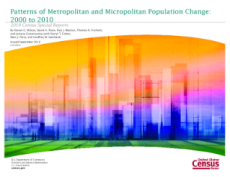Patterns of Metropolitan and Micropolitan Population Change: 2000 to 2010
Patterns of Metropolitan and Micropolitan Population Change: 2000 to 2010
Introduction
Results of the 2010 Census show that the U.S. population is larger, older, and more racially and ethnically diverse than ever before. While the overall growth for the decade slowed to 9.7 percent, this value for the United States reflected substantial geographic variation, with rapid growth in some areas of the country and sizable population declines in others. Indeed, all major demographic measures exhibited variation within the country. In this 2010 Census Special Report, we examine contemporary geographic patterns for the following demographic topics: population distribution and density, race, Hispanic origin, and age and sex structure. We also examine how these patterns have changed between 2000 and 2010. Providing both geographic and historical context can assist users in better understanding the often complex demographic processes at play in the nation.
This report examines subnational demographic variation through the lens of metropolitan and micropolitan statistical areas. Metro areas and micro areas, as they are colloquially known, are useful geographic units for analyzing the U.S. population. States are sometimes too large a unit to provide meaningful subnational analysis, obscuring patterns worthy of attention from regional or even national perspective. Counties, on the other hand, number more than 3,000 and can be too small and numerous for some purposes. Metro and micro areas, as socially and economically integrated groupings of one or more counties, provide appropriately detailed geographic analysis as well as good mapping units for a national overview. Furthermore, in several chapters we also examine census tract data to provide a neighborhood-level perspective on demographic patterns within individual metro areas.
Concluding this introduction is a section—Understanding the Maps—with examples and descriptions of the types and styles of maps used in the report. From national metro and micro area maps to detailed tract-level maps, the guide presents examples to assist readers as they explore each chapter. The maps provide location and context for the findings in each section.
The report’s five chapters then follow. Chapter 1—Overview of Metropolitan and Micropolitan Statistical Areas—discusses metro and micro areas, how they are delineated, the number of areas, and the distribution of the population among them. Chapter 2—Population Growth and Decline—examines overall metro and micro area population change, the most rapidly changing areas, and population change within some of the largest metro areas. Chapter 3— Population Density—looks at population concentration in two different ways by examining overall population density as well as density by distance from the historic cores of the larger metro areas. Chapter 4—Race and Hispanic Origin—explores the increasing diversity in the spatial distribution of selected race and Hispanic origin groups. Chapter 5—Age and Sex Composition—looks at the age and sex structure of metro and micro area populations and how it has changed since 2000.
The topics highlighted in the report offer a cross section of much of the population content found in the 2010 Census. These variables also provide a basic demographic context for any other variables of interest to the reader, such as income or poverty.
This report includes several innovative aspects worth mentioning here. First, to assist in our analysis of population change from 2000 to 2010 at the subcounty level, we retabulated Census 2000 in updated 2010 Census geographic boundaries. By doing so, we were able to calculate decennial population change at the census tract level. This would not otherwise have been possible, given the instability of some census tract boundaries between the two censuses. Second, we examined the spatial context of population change within metro areas. For instance, was population growth this past decade higher in neighborhoods inside large cities or in outlying suburbs? To operationalize these concepts, we determined the location of city hall for the largest city in each metro area and used that as a proxy for the area’s original downtown or central business district. We then constructed distance bands radiating out from the city hall and were able to present results in a broad spatial context.
Due to space limitations, the report itself often includes only an example map or graphic for a particular metro or micro area. The accompanying online content includes a mapping interface, data tables for all metro and micro areas, and many additional population pyramids and distance profiles.
Tables
File Layout
Visualizations
Visualization
Visualization
Data Tools
Others in Series
Publication
Publication
Publication








